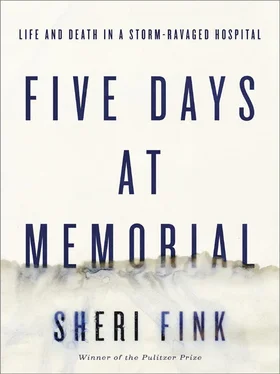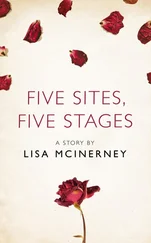Fortunately, the ultrasound exam showed that the knife had not penetrated the membrane around the woman’s heart. Open-chest surgery wouldn’t be necessary. The team hadn’t liked the thought of attempting it on backup generator power. Wynn’s ICU had one available bed. The woman was taken by elevator to the eighth floor.
The ICU nurses on the overnight shift received their new patient at about six a.m. and began positioning the tangle of equipment that had taken over for many of her bodily systems. The machines breathed for her, checked her blood pressure at regular intervals, measured her pulse, pumped fluid into her veins, and monitored the oxygen level in her capillaries—all just as if a hurricane had never happened.
A nurse rolled a cart with a computer up to the woman’s bedside and began documenting her progress. Some of the ICU nurses had radios on their carts. They tuned them to WWL, a popular 50,000-watt talk radio station that was broadcasting on generator power.
On the radio, the president of neighboring Jefferson Parish announced that martial law had been declared. The hosts aired his message repeatedly, but martial law—an extremely rare assumption of police powers by the military typically requiring an act of Congress—had not, in fact, been declared in the disaster zone.
A caller complained that looters were ravaging New Orleans. She didn’t say how she knew this, but the radio host took her at her word and amplified her outrage to thousands of listeners. “If someone is breaking into businesses and looting merchandise, these people should be shot,” he said. “We’re under martial law here.”
Throughout the early morning, callers began describing something even more ominous. Water from the storm was still sitting in the streets. One resident was mystified because he could hear the city’s drainage pumps running. “My question is,” he said to the host, “if you live a block away from the pumping station, and the pumping station is working, why would you have water in your house?” The host had no answer.
“We’re very frightened,” a man named Freddy said calmly, and described his situation. He was sitting in the attic of his home in the Gentilly neighborhood near Lake Pontchartrain, surrounded by about nine feet of water. The area, one of those that had flooded badly in the 1927 storm, was several miles northeast of Memorial. With him were four other people, including a baby. They had punched a hole through the roof and, using candles, a lantern, and a flashlight, had tried for four hours to signal a helicopter.
“And is the water rising anymore?” the host asked him.
“Yes, it’s steady rising, yes.”
“The water’s rising?” one nurse asked aloud in the medical ICU at Memorial. It made no sense. The street flooding around the hospital had gone away. Anyone who had taken a break and ventured outside during the night knew it was clear and still. The news was confusing and worrisome, but there was work to do.
The sun rose, and around Memorial the streets remained dry. The sky outside the windows was blue. At seven a.m., after the stabbed patient was settled in, nurse manager Karen Wynn went downstairs to the relocated command center on the fourth floor for the day’s first meeting of the disaster leadership team.
The meeting took place in a large, rectangular room marked NURSING RESOURCE CENTER. White linoleum tables held a bank of computers normally used for training nurses. The computers were connected to the Internet and plugged into the red emergency outlets that operated off the generator system.
The room offered a sense of remove. Homey pink, pleated valances framed windows overlooking a courtyard enclosed by the reddish-brown tapestry brick of the old hospital building. There were mismatched sofas, brown cabinets, and a sink. The hospital’s chief financial officer, Curtis Dosch, had brought over a television set with a rabbit-ear antenna, placed it on a low table, and plugged it into a red outlet. Staff hunched down to peer at it, though it showed mainly static.
Susan Mulderick, Wynn’s longtime boss, ran the meeting. Wynn trusted Mulderick, who had hired her as a staff nurse when she started her career in the 1980s, then promoted her to manager when Wynn was pregnant and on bed rest. While others saw only the professional, intimidating Mulderick, Wynn knew inside she was a marshmallow, a cream puff. She had always set clear expectations and given Wynn the freedom and support she needed to meet them. Wynn adored Mulderick and admired her intelligence and creativity.
The command team announced a shift in hospital operations from “assault mode” to “survival mode.” This unofficial designation reflected news they had received minutes before the meeting. An Acadian ambulance worker on-site had confirmed with his dispatchers that one of the canals in New Orleans had been breached. That meant water could be headed toward the hospital. Memorial’s workers might be exhausted, but they were beginning to realize that rather than signing out their patients to the returning “B” team and going home, they could be stuck at the hospital for a while.
Wynn and the other department heads checked in. Their reports were relatively upbeat. The hospital was functioning almost normally, in spite of the heat. Maintenance workers were picking up debris, taking down floodgates, and patching holes in the roof exposed when the wind ripped away ducts and flashing. Kitchen employees were handing out Styrofoam cups filled with scrambled eggs and bacon. (The sight of low-wage cooks tending the stoves in the swelter with tied-up hair and cut-off sleeves and scrub pants had awed one executive who came down to the kitchen seeking extra food for a patient. An employee turned and asked, “What you need, baby?” as if it were any other day.)
Feeding not only the patients but also everyone else, it was thought, might help calm the hundreds of family members and hospital neighbors who had taken shelter at Memorial and were getting antsy. With downed trees and power lines on the streets and reports of flooding only blocks away, it wasn’t safe for people to leave, though many were trying. Some headed to a darkened Winn-Dixie supermarket about eight blocks away and returned, arms laden with diapers, food, and drinks. One described this as “soul surviving, surviving for the soul.” Others considered it looting.
After the meeting broke up, a memo went out to reinforce what the command team had decided: “Incident Command has declared Survival Mode for Memorial Medical Center.”
All staff and physicians were instructed to stay at the hospital. Family members were advised to stay too. The hospital could expect flooding. There would be no elective surgery and no MRIs, PET scans, or CTs. Medically stable patients were to be discharged, even though they may not have had anyplace to go or any way of leaving. Some were taken to the lobby in wheelchairs to wait. The head pharmacist was still scrambling to arrange for a drop-off from his supplier to replace the dwindling stores of medicines.
Each department had to report to the command team by noon with a list of employees and family members present and an inventory of available medicines, supplies, equipment, and cell phones, as the hospital’s landlines worked only intermittently. The command team also sought any nurse with experience performing kidney dialysis. Patients in renal failure needed hours of dialysis every few days to clean their blood and remove fluid from their bodies, but the city’s dialysis clinics were closed. Their clients were showing up at the hospital, where there was only one dialysis nurse on hand for Memorial and LifeCare patients, including some of the new patients transferred from Chalmette. A nursing director from LifeCare and another nurse volunteered to help, and they tutored the kidney specialist, a doctor who was adept at ordering dialysis, not providing it.
Читать дальше












